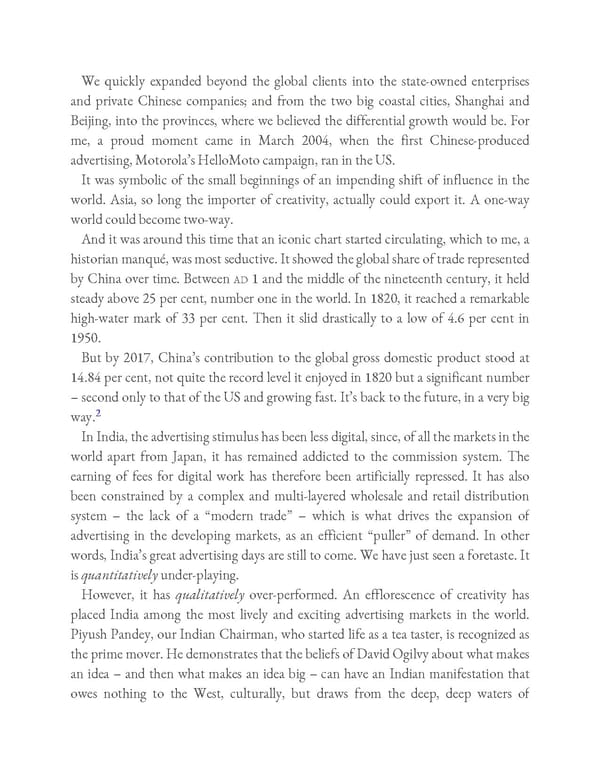We quickly expanded beyond the global clients into the state-owned enterprises and private Chinese companies; and from the two big coastal cities, Shanghai and Beijing, into the provinces, where we believed the differential growth would be. For me, a proud moment came in March 2004, when the first Chinese-produced advertising, Motorola’s HelloMoto campaign, ran in the US. It was symbolic of the small beginnings of an impending shift of influence in the world. Asia, so long the importer of creativity, actually could export it. A one-way world could become two-way. And it was around this time that an iconic chart started circulating, which to me, a historian manqué, was most seductive. It showed the global share of trade represented by China over time. Between AD 1 and the middle of the nineteenth century, it held steady above 25 per cent, number one in the world. In 1820, it reached a remarkable high-water mark of 33 per cent. Then it slid drastically to a low of 4.6 per cent in 1950. But by 2017, China’s contribution to the global gross domestic product stood at 14.84 per cent, not quite the record level it enjoyed in 1820 but a significant number – second only to that of the US and growing fast. It’s back to the future, in a very big 2 way. In India, the advertising stimulus has been less digital, since, of all the markets in the world apart from Japan, it has remained addicted to the commission system. The earning of fees for digital work has therefore been artificially repressed. It has also been constrained by a complex and multi-layered wholesale and retail distribution system – the lack of a “modern trade” – which is what drives the expansion of advertising in the developing markets, as an efficient “puller” of demand. In other words, India’s great advertising days are still to come. We have just seen a foretaste. It is quantitatively under-playing. However, it has qualitatively over-performed. An efflorescence of creativity has placed India among the most lively and exciting advertising markets in the world. Piyush Pandey, our Indian Chairman, who started life as a tea taster, is recognized as the prime mover. He demonstrates that the beliefs of David Ogilvy about what makes an idea – and then what makes an idea big – can have an Indian manifestation that owes nothing to the West, culturally, but draws from the deep, deep waters of
 Ogilvy on Advertising in the Digital Age Page 431 Page 433
Ogilvy on Advertising in the Digital Age Page 431 Page 433